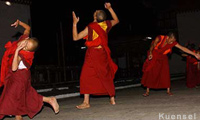 |
Bhutan Festivals |
|
 |
Bhutan Festivals |
|
|
 |
| TSHECHU (RELIGIOUS FESTIVAL) |
|
Thimphu
DRUPCHEN AND TSHECHU - Mask Dances
|
 |
 |
| Monks of the central monk body do a final rehearsal in the courtyard of
the Tashichhodzong. |
The
eleven-day annual Lhamoi Drupchen, a rite performed to appease the
protecting deity Pelden Lhamo (Mahakali), will be held in September. |
|
Pelden
Lhamo (whose name translates as "Glorious Goddess") is the only
female dharma protector common to all four schools of Buddhism and
one of the three main protecting deities of Bhutan.
The
clergy is performing a three-day rite for the Thimphu Domchoe while
the Lham Tsomo dance, a highlight of the Thimphu Domchoe festival,
will be performed in the courtyard in the Tashichhodzong.
The Drupchen was instituted sometime between 1705 and
1709 by Kuenga Gyaltshen, the first
reincarnation of Jampel Dorji, the son of Zhabdrung Ngawang Namgyal.
According
to legend, Pelden Lhamo appeared before him and performed the dances while
he was in meditation. Based on these dances, Kuenga Gyeltshen initiated
the Drubchhen.
According
to the tradition of Lama Gongdue the annual Thimphu Tshechu,
introduced in 1670 on the eighth month of the Bhutanese calendar during the reign of the fourth Desi,
Tenzin Rabgye (1638-1696). The annual Thimphu Tshechu will take
place over four days end of September to commemorate the birth anniversary
of Guru Rinpoche.
From the time of Gyalsey Tenzin Rabgye,
based on various relevant biographies and autobiographies of saints and
rulers of the past, compassionate mask dances in the form of peaceful and
wrathful figures of most Ter-chams (sacred dances) have been composed
and are being presented for the well being of those present on the occasion,
according to the Royal Academy of Performing Arts (RAPA).
In
other religious events, the annual Phurpai Drupchen (Vajra tradition)
ceremony at the National Memorial Chorten will conclude also
end of September with the Nguedup Langwa (receiving of spiritual wisdom/power) in the morning and Jinseg (a sacred fire offering) later in the
day.
The
sacred 11-day ceremony is performed by His Holiness the Je Khenpo and 250 monks of the central monk body at the Dukhang (congregation
hall) of Tashichhodzong for 22 hours at a stretch in a day with
short break for meals and rest.
The
Thimphu Tshechu last for fours days during which mask and historical
folk dances are performed in the courtyard of the Tashichhodzong. All
the offices and institutes in Thimphu will remain closed for four days
to mark the Tshechu.
top
| Raksha Mangcham - Dance of Judgment Day |
 |
 |
|
One of today’s highlights on day two of the Thimphu tshechu is the Raksha Mangcham, which portrays the full trial system after death in the court of the Lord of the death.
The dance, which last four to five hours, portrays Shinje Chhogyel (Lord of Death), Lha Karpo (white god) and Dreynakchung (black demon) as the three main dancers.
The three of them are said to be representations of the Rigsum GonpoJampelyang, Chenrizig and Chana Dorji respectively.
|
|
Shinje Chhogyel is the lord of death.He has a fearful crimson face with three eyes.He carries a thramshing in his right hand that signals who is dead from the world, and a mirror in the left that shows what good and bad the deceased has done as a human being.
To his right is the Lhakarpo.He is completely white and holds a rosary in the left hand.In his right hand, he carries white counting stones that weigh the good work done by the person when alive.
To his left is the fearful character with three bulging eyes and a scary sight to children.He is a tall, dark figure dressed completely in black, with a big black mask and a yak tail sticking out from the top.
The Dreynachung (black demon) at every tshechu is a welcome change, after a marathon of mask dances and atsaras entertaining the crowd.But the Draynachung is not just there to silence crying children.Its significance during the raksha mangcham (dance of rakshas and the judgment of the dead) goes beyond life.
When a person is born, he comes with a god and a demon that rest on the two shoulders.From the first day, they record how much sin one commits or merit one earns in a lifetime.
The raksha mangcham dance, which contains more elements of a drama than dance, shows how a person, who has died and is in the state of bardo (intermediate state), is judged for the sins and merits accumulated in a lifetime.
The Dreynachung represents the modern day prosecutor of the dead.He represents the evil, and his attire and mask remind people of the fate of committing sins.
The Raksha, an ox-headed dancer, who represents the head of the persecution committee and the justice minister, leads the dance.He is followed by the monkey, who weighs the sins of the deceased.Next comes the pig, who on viewing the thramshing, goes in search of the deceased together with the garuda, lion, bear, and snake.
The dance portrays the typical case of two personalities: the sinner (Nyelwabum) and the virtuous man (Chimdapelkye).The sinner is sent to the hell and the good doer to the heaven.
Watching the dance brings everyone to the reality of life after death.
| This
article was contributed by Tashi Phuntsho, KUENSEL, Bhutan's National Newspaper
2012 |
 |
| Information on Bhutan |
 |
|





